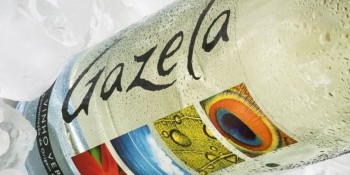“Vinho Verde” — could that really mean “green wine”? Literally, yes, it translates from Portuguese as green wine, but “green” here is meant to convey youth, not color. These wines are normally meant to be enjoyed in the first few years after they are bottled. It is an enjoyable wine, particularly in the summer, and is widely available for less than 10 bucks.
Is this too good to be true? I’m here to tell you, it is not. This is a wine that has exploded in popularity recently, with Portugal exporting triple the volume to the United States in 2012 versus 2002.
The grapes for Vinho Verde are grown in the northwest corner of Portugal. This northern area is mostly within Minho province, home to another green specialty, caldo verde, a soup of potatoes and collard greens. Most grape growers in the area are small or family operations that grow other produce in addition to grapes. Consequently, grapevines are grown much higher up, on high trellises or even up telephone poles or the trunks of trees, so that vegetables can be grown near the ground. Minho province gets a considerable amount of rainfall each year, and growing vines higher off the ground helps avoid rot and other fungal diseases on the grapes.
The wine name is not synonymous with the grape varietal used. In fact, many different grapes are allowed in making a wine labeled Vinho Verde, including Albariño, Arinto, Avesso, Azal Branco, Loureiro, and Trajadura for white Vinho Verde. (The wine can be red or rosé as well.) Aside from Albariño, which is sometimes labeled Vinho Alvarinho to denote the specific varietal, these grapes are likely unknown to most people outside northern Portugal.
And what about the wine itself? The whites, in particular, are perfectly suited for summer sipping. They are light, refreshing, and effervescent. They do not qualify as sparkling or even semi-sparkling, but the carbonation is definitely noticeable. The wines are normally acidic to heavily acidic; if you prefer oak barrel aged, buttery chardonnay, this might not be your wine. But if you enjoy riesling or sauvignon blanc, this is definitely something you might want to try.
On the nose, these wines are often very aromatic, with fresh pear, peach, apple, and lemon tastes. The acidic flavors make it a perfect pairing with seafood; the more acidic, less fruity offerings are tremendous with shellfish. The whole essence of the wine — light, refreshing, acidic, quasi-sparkling, with lighter fruit flavors and low alcohol (between 8.5 and 11 percent) — screams for a long, relaxed meal of seafood dishes while sitting outside on a perfect day.
Gazela Vinho Verde, my very first experience with this wine style, is a great one. It is zesty, acidic, and fresh, with a thirst-quenching pear, lime, and grapefruit combination on the palate. Take a few more sips and you’ll find hidden gems beneath the surface: fresh ginger, apricot, and tangerine. The wine has an ocean-air quality to it, like you can almost-but-not-quite taste the salt. It’s a steal at $8.
Hera Vinho Verde Branco was fantastic as well — and another bargain at $10. It is all citrus and melon on the very fragrant nose, followed honeydew, citrus, pear, and floral notes on the palate. The acidity here is racy but is mellowed by some slight residual sugar; combined with the effervescence, the wine is very well-balanced.
Finally, I wanted to mention Quinta da Aveleda Vinho Verde, which may appeal to some who are less inclined to drink acidic wine. A few years ago, Joshua Greene, Publisher and Editor of Wine & Spirits Magazine, called this the best wine value in the world. The wine is not as light as the Hera or Gazela — it has a little more weight to it, but still is certainly not heavy — and does not possess the sparkling quality of the other two. The flavors are citrus-focused, with an intriguing rose petal component — still acidic, but not necessarily racy or zesty (though this will undoubtedly depend on the vintage), and another steal at $9.
Portuguese wine as a whole is underrated. The big, powerful reds are often overlooked in favor of more prestigious Châteaux in France or more trendy wineries on the West Coast of the United States. Even port wines are not popular, though they do have a special following. Vinho Verde is a great way to start exploring Portuguese whites.
Swirl, sniff, sip.
